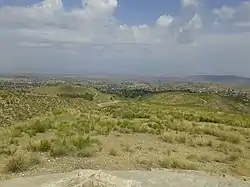Karak District
Karak District (Pashto: کرک ولسوالۍ, Urdu: ضلع کرکⓘ) is a district in Kohat Division of Khyber Pakhtunkhwa province in Pakistan. It is situated to the south of Kohat District and on the north side of Bannu and Lakki Marwat districts on the main Indus Highway between Peshawar and Karachi – it is 131 km from the provincial capital Peshawar. It gained a district status in 1982, prior to which it was part of Kohat District.[3]: 1
Karak District
ضلع کرک کرک ولسوالۍ | |
|---|---|
 Landscape in Karak district | |
.svg.png.webp) Location of Karak District (highlighted in red). | |
| Country | |
| Province | |
| Division | Kohat |
| Government | |
| • Type | District Administration |
| • Deputy Commissioner | Sharukh Ali Khan[1] |
| • District Police Officer | N/A |
| • District Health Officer | N/A |
| Area | |
| • Total | 1,234 km2 (476 sq mi) |
| Population (2017)[2] | |
| • Total | 705,362 |
| • Density | 570/km2 (1,500/sq mi) |
| Time zone | UTC+5 (PST) |
| Number of Tehsils | 3 |
| languagea | Pashto & Urdu |
| Website | karak |
It is natively inhabited by the Khattak Pashtun tribe who make the majority of the population.
Demographics
| Year | Pop. | ±% p.a. |
|---|---|---|
| 1951 | 99,908 | — |
| 1961 | 121,199 | +1.95% |
| 1972 | 191,204 | +4.23% |
| 1981 | 249,681 | +3.01% |
| 1998 | 430,796 | +3.26% |
| 2017 | 705,362 | +2.63% |
| Sources:[4] | ||
At the time of the 2017 census the district had 72,207 households and a population of 705,362. Karak had a sex ratio of 1025 females per 1000 males and a literacy rate of 63.75% - 84.37% for males and 44.41% for females. 51,086 (7.24%) lived in urban areas. 30.82% of the population were under 10 years of age. 285 (0.04%) people in the district were from religious minorities. Pashto was the predominant language, spoken by 99.16% of the population.[2]
Resources
There are several natural resources that have been discovered in Karak. The salt mines were well known in antiquity and a major source of salt for the Indian subcontinent into British imperial times. More recently oil, gas, and uranium have all been discovered. Oil and gas reservoirs have been found in the towns of Makori, Noshpa Banda, Gurguri and Lachi circle.
Oil and gas reservoirs explored in Karak district are producing 7000 barrels of oil and 2500 cubic feet gas on a daily basis which is a record production from one oil well in the country.[5] The oil and gas reservoirs at Noshapa Banda in district Karak are generating millions of rupees revenue daily. District Karak has mineral resources and many national and international companies and OGDCL are busy in oil and gas exploration in different areas of the district. Vast reservoirs of oil and gas have been explored in Gurguri and Noshpa Banda areas of the district so far whereas exploration is under way in other areas.
According to a serve conducted by International Nuclear Information System [6] where Fission Track Technique has been applied for the estimation of uranium in 30 drinking water sources of Tehsil Takht-e-Nasrati ,Shnawa Gudi khill and District Karak, Kpk, Pakistan. These samples have mean, minimum and maximum concentration of uranium of 13.45 +- 3.207, 1.07 +- 0.6, 84.23 +- 15.63 micro g l/sup -1/, respectively. The significant finding was the observation of very high level of uranium in drinking water sources obtained from uranium rich bedrocks than the safe limit of WHO (15 micro g l/sup -1/) for human consumption. On the basis of this study, it was concluded that the origin of uranium is potentially due to one of the Asia richest mineral deposit of uranium in Karak, Pakistan. The results could be of vital concern in diagnosis and prognosis of uranium induced disease in the local population under investigation.
Representation in Assemblies
| Member of Provincial Assembly | Party Affiliation | Constituency | Year |
|---|---|---|---|
| Mian Nisar Gul Kakakhel | Muttahida Majlis-e-Amal | PK-85 Karak-I | 2018 |
| Zafar Azam | Muttahida Majlis-e-Amal | PK-86 Karak-II | 2018 |
| Shahid Khattak | PTI | NA-34 Karak | 2018 |
Administrative divisions
The district of Karak is administratively subdivided into three Tehsils.[7] Shortly after Annexation by british in 1849 Kohat was District with THree Tehsils, Kohat , Hangu and Teri tehsil . Hangu and Teri tehsils was granted to khan on lease. Teri tesil was subdivided into tappas(equal to today Union council) under tapedars and Villages under following khans: Teri,Chakhtu, jandri, Dam kalla, kabir kalla , ghundi shabaz khan , ghundi mir khan khel, methakhel, and one village in thal . [8]
- Banda Daud Shah (Urdu: تحصیل بانڈہ داؤد شاہ)(Pashto: بانډه داود شاه تحصیل)
- Karak (Urdu: تحصیل کرک)(Pashto: کرک تحصیل)
- Takht-e-Nasrati (Urdu: تحصیل تخت نصرتی)(Pashto: تخت نصرتي تحصیل)
Neighboring areas
References
- "Karak".
- "District Wise Results / Tables (Census - 2017)". www.pbscensus.gov.pk. Pakistan Bureau of Statistics.
- 1998 District Census report of Karak. Census publication. Vol. 97. Islamabad: Population Census Organization, Statistics Division, Government of Pakistan. 2000.
- "Population by administrative units 1951-1998" (PDF). Pakistan Bureau of Statistics.
- "Vast reserves of oil, gas in Karak". DAWN.COM. 20 December 2009. Retrieved 27 September 2017.
- "Estimation of uranium concentration in drinking water sources of tehsil takht-e-nasrati, district karak, khyber pakhtunkhwa, pakistan using fission track technique". iaea. 20 December 2009. Retrieved 27 September 2017.
- "Pakistan Bureau of Statistics Census 2017" (PDF). www.pbscensus.gov.pk. Archived from the original (PDF) on 29 August 2017. Retrieved 26 September 2017.
- "Report on the Settlement of the Kohat District in the Panjab". 1884.
